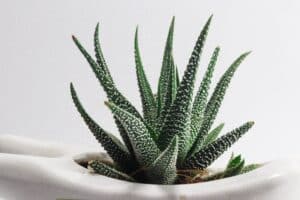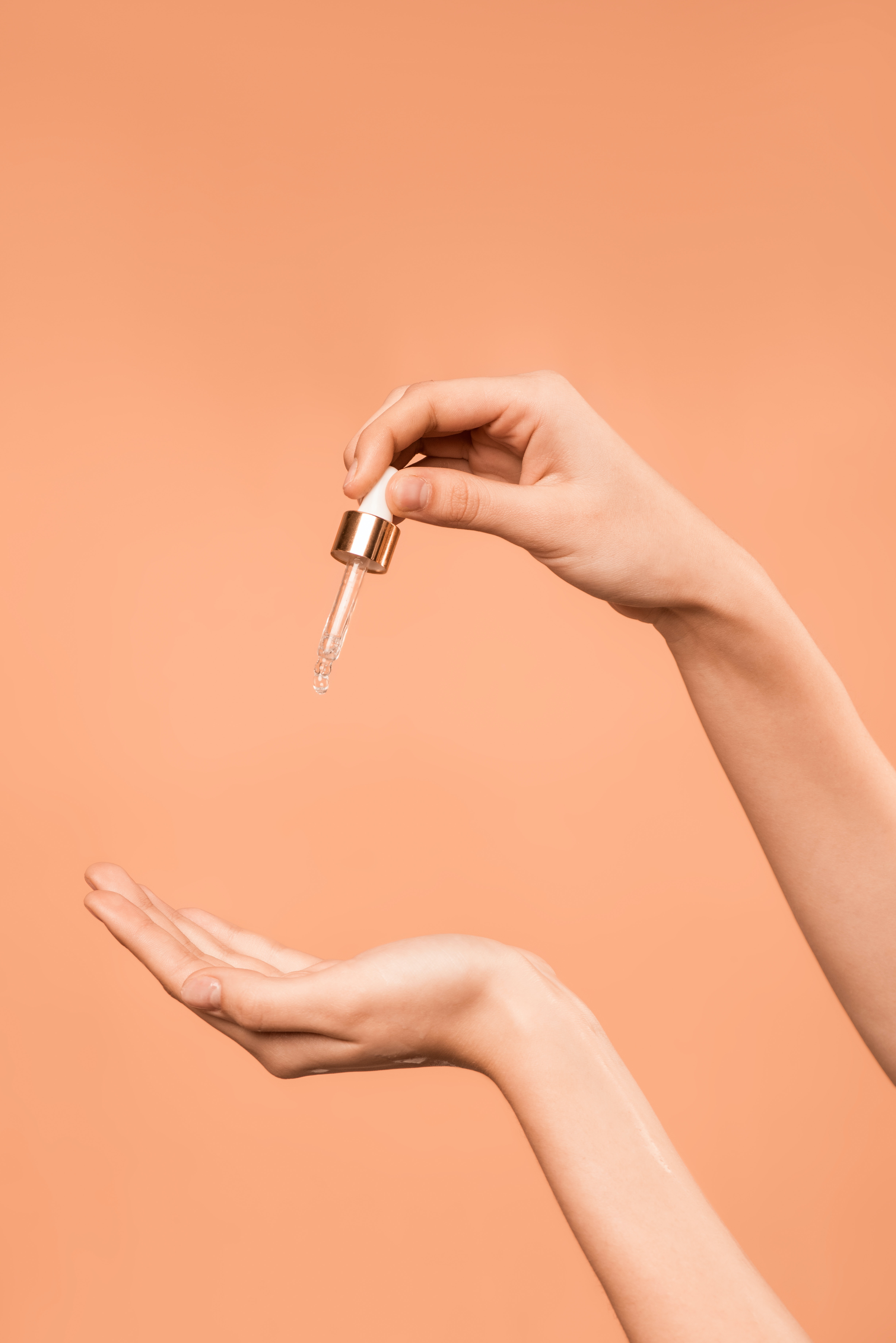Aloe vera is a very popular plant and natural ingredient. It is a popular houseplant because it is easy to take care of and a popular body care ingredient because there are a lot of marketed benefits of aloe vera for the skin. One of the most common benefits of aloe vera for the skin is its soothing agent. People use it after they get sunburns or when they have damaged their skin barrier.
What is Aloe Vera?
Aloe vera belongs to the succulent group of plants. There are more than 500 species of aloe vera, and it originated from the Arabian Peninsula. Although the cactus-like plants grow well in hot dry climates, they are widely available in many countries today. The aloe vera plant has three main parts. The outside of the plant that you see when you look at it is called the rind or cuticle after that is the outer leaf, and then lastly, the clear inside that looks like jelly is called the mucilaginous tissue.

The outer leaf produces a bitter yellow liquid that contains molecules called anthraquinones. Anthraquinones behave as laxatives, and in the United States, this was actually the more common use of aloe originally. When people are talking about the benefits of aloe vera for the skin, they are typically not talking about the outer leaf but instead the inner jelly. Ancient civilizations used the inner jelly-like substance to treat cuts and scrapes on the skin, but today there are many more claimed benefits of aloe vera for the skin.
Benefits of Aloe Vera for the Skin
Some of the most popular benefits of aloe vera for the skin are as a soothing and moisturizing ingredient. However, there are also some marketing claims around aloe vera being able to fade dark spots, manage acne, and slow the signs of aging.
Related Post: Understanding the Science Behind Aging in Skin: Tips for Youthful Glow
The aloe vera plant does have a ton of biologically active molecules in it. There are more than 75 different chemicals and compounds in the jelly-like center of the aloe vera plant. There are vitamins, enzymes, sugars, acids, and more. So let’s talk about these claims and if they are science-backed benefits of aloe vera for the skin.
Moisturizing
Aloe vera does moisturize the skin. That marketing claim is science-backed. The inner jelly of an aloe vera plant is 99% water. So there is plenty of water in the aloe plant that the skin can grab. Additionally, similar to several other natural hydrators like honey and alginate, the sugars in the plant attract and hold water molecules. This means that aloe vera is a humectant. Hyaluronic acid is another popular skincare ingredient that is a humectant. Due to the thick consistency of the jelly, it is also an emollient because it forms a protective layer over the skin to lock in moisture, but the layer is not impermeable.
Related Post: What Does Hyaluronic Acid Do: A Complete Guide
Both of these properties make aloe a really good product for dehydrated skin or protecting skin after a burn or damage to the skin barrier. Being an excellent moisturizer is one of the greatest benefits of aloe vera for the skin. As we talk about the other benefits of aloe vera for the skin, it is important to point out that aloe vera jelly is 99% water. This means that all of the other components only make up 1% of the gel, so the other active ingredients that are present in aloe vera are present in very small amounts. This is important because, when you think about the necessary concentration of actives for them to be effective in skincare, typically, they are greater than 1%.
Related Post: 10 Effective Hyaluronic Acid Alternatives

Soothing
Aloe vera also has science-backed soothing properties. In addition to being a humectant due to the sugars present in aloe vera, aloe vera is also an emollient. Emollients are ingredients that soothe and soften the skin by increasing the level of moisture in the skin. Aloe vera is soothing after a sunburn or damage to the skin barrier because the water-rich gel holds the water onto the skin, and softens dry flaky skin tissue that can feel itchy and even painful. Keeping an area moisturized after damage to the skin barrier gives the skin time to heal and protects the lower layers from additional damage.
Antioxidant
There is evidence that aloe vera contains vitamins and minerals that behave like antioxidants. However, the concentration of these antioxidants in aloe vera is on the order of tenths of a percent. This means it’s not going to be an effective dosage of antioxidants. For example, an anti-oxidant like ascorbic acid, vitamin C should be at a minimum of 3% to be effective in topical applications.
Even if all of the antioxidant ingredients in aloe vera were added together they are still not equivalent to a level that would be necessary to be effective. This does not mean that there is not some minor antioxidant benefit that aloe vera could have. However, it is not a substitute for an antioxidant serum like vitamin C or niacinamide. And none of these ingredients is a substitute for sunscreen, which is the first line of defense and the most important product in UV protection and preventing sunburn, skin damage, or premature aging.
Related Post: Why is Sunscreen Important?
Anti-Aging
Any ingredient that promotes hydration and keeps the skin moisturized will help reduce some signs of aging. Wrinkles are one of the hallmarks of mature skin and when the skin is hydrated superficial wrinkles will temporarily disappear or be reduced. So there is science that supports aloe vera having a limited anti-aging benefit because it hydrates the skin.
However, there are some claims that aloe vera can cause collagen production, and while there is some evidence that supports this in open wounds, there is no evidence of this in topical skincare. Often parallels are drawn from wound healing to skin care because they both are related to skin tissue. However, the results are not directly translatable. because it is not the same. Active ingredients perform very differently when they are placed on top of the skin and have to penetrate the skin barrier versus placed directly on top of the dermis at the site of a wound.
Acne
Studies have shown that aloe vera extract can contain some salicylic acid which is a beta-hydroxy acid, BHA, that has anti-inflammatory and antimicrobial properties. In skincare, it is commonly used in products that are formulated for acne-prone skin. Salicylic acid in a topical formulation needs to be in a concentration of a minimum of 3% to be an effective treatment for acne. So similar to the antioxidants that are found in aloe vera, there is not enough salicylic acid for it to be an effective acne treatment. If acne is one of your skin concerns, then using a product that contains salicylic acid at a clinically relevant concentration would be a better route to address your skincare concerns.
Hyperpigmentation
In addition to being an acne-fighting ingredient, salicylic acid can also be used to address hyperpigmentation. Salicylic acid is an acid which means it has exfoliating properties. When applied to the skin at the right minimum concentration it can remove a layer of skin cells to reveal a fresh new layer of skin. Exfoliation in combination with other treatments is an effective way to get rid of hyperpigmentation. However, specifically the concentration of salicylic acid that is in aloe vera is not high enough to produce this result.
Related Post: What Causes Hyperpigmentation: The Science Behind Clearer Skin
Aloe vera also contains vitamin a, which is the vitamin family that retinol and retinol derivatives belong. However, just like the salicylic acid, the concentration is low and probably not effective. Using a dedicated prescription strength retinol like tretinoin which has a lot of scientific evidence supporting it, or over-the-counter retinol like adapalene would be a much more effective hyperpigmentation treatment.
If are working to address hyperpigmentation with your skincare routine, one way that aloe vera can be helpful is as a soothing step after exfoliation or a cell turnover-promoting active like retinol. Using an aloe vera gel as the final step in your routine or on days that you are not exfoliating or using retinol could help your skin from the redness, dryness, or itchiness that sometimes comes with over exfoliation or retinizing your skin. So aloe vera can be helpful in your hyperpigmentation regimen, but it will not be the ingredient fading dark spots.
How to Use Aloe Vera in Your Skincare Routine?

Although aloe vera is not a substitute for actives in your routine like antioxidants, exfoliants, or retinol, it does have benefits. Aloe is an excellent moisturizing and soothing ingredient. With all of the water that is naturally present in the aloe gel and the sugars present, it has the double benefit of being a humectant and an emollient. If you want to incorporate aloe vera into your skincare routine, using it as your last water-based step in your evening routine would be my recommendation.
- Aloe vera is pretty viscous, so it could interact with your sunscreen and create piling if you try to apply it in your daytime routine.
- In your nighttime routine, you do not want to apply it before your actives because it can affect their ability to penetrate, which reduces their effectiveness.
Are there any products that you use that have aloe vera in them that you love? Let me know in the comments below.
References
Pharmacological attribute of Aloe vera: Revalidation through experimental and clinical studies, Aloe vera: a systematic review of its clinical effectiveness, Efficacy of aloe vera cream in prevention and treatment of sunburn and suntan, Aloe Vera: A Short Review, A Randomized Comparative Trial on the Therapeutic Efficacy of Topical Aloe vera and Calendula officinalis on Diaper Dermatitis in Children, An Evidence-Based Systematic Review of Aloe vera by the Natural Standard Research Collaboration, Aloe Vera for Tissue Engineering Applications

1 Comment